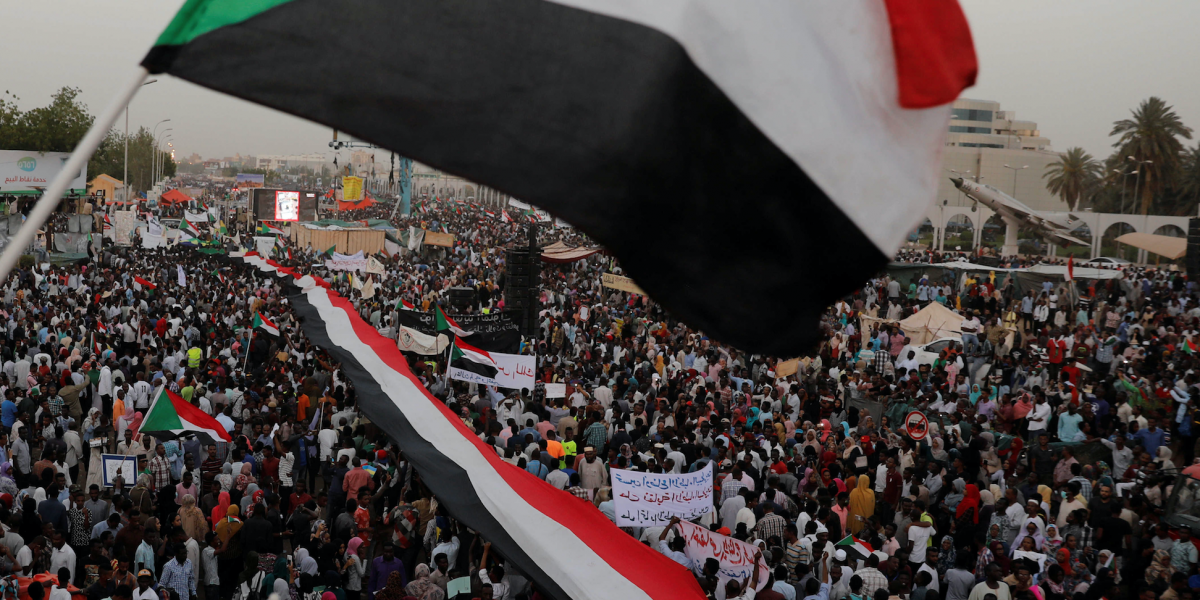Mass movements erupted all over the world in 2019, as millions of ordinary people protested austerity, corruption, climate change, and oppression. Some movements have already toppled governments, giving us a glimpse of what could be in store for 2020, while others are only now coming to a head. Win or lose, their outcomes will be felt globally and affect whether other struggles spread, stagnate, or retreat.
At the beginning of the new year, we look at twenty key struggles around the world that could make 2020—like 2019—another year of revolt.
Canada
1. The fight for Indigenous sovereignty
Since Idle No More emerged in late 2012, Indigenous activists have transformed the environmental movement in Canada. By 2019, Indigenous sovereignty and reconciliation had become foundational demands for climate justice, at least in the most advanced sections of the movement, while Indigenous youth played a visible role in the climate strikes on September 20 and 27.
This development has helped orient activists to the most urgent—and concrete—struggle for climate justice in 2020: the fight against pipelines. Following the federal election, Trudeau’s priority is completing the Trans Mountain Pipeline “as quickly as possible”—the movement’s priority must be defeating it.
Building solidarity with Indigenous struggles has become more urgent since the Guardian revealed RCMP plans to use lethal force against activists in Wet’suwet’en nation who attempted to block construction of the Coastal GasLink pipeline across their territory in northern British Columbia.

2. Ontario teachers versus Doug Ford
In April 2019, 100,000 students at over 600 schools across Ontario led a record-breaking walk-out over education cuts and increases to class sizes; the next day, 60,000 teachers and their supporters descended on Queen’s Park for a Rally for Education. By October, 55,000 education workers had forced the Ontario government to reverse hundreds of millions of dollars in education cuts, by credibly threatening a strike during the federal election.
By the end of 2019, Ontario teachers had conducted three one-day strikes against Premier Doug Ford’s cuts to education, but the fight is far from over and the stakes couldn’t be higher: if Ford defeats the teachers, it would be a blow to all other public sector workers whose collective agreements will soon expire. But if the teachers defeat Ford, it would add momentum to the growing opposition to Ford’s austerity agenda, and keep the Tories on the back foot.
To win, Ontario teachers must build support among their membership for an all-out strike and pressure their leadership to escalate. Community activists could show solidarity by building support for the teachers among students and parents.
3. Alberta’s public sector versus Jason Kenney
Just months after their election in April 2019, Premier Jason Kenney’s Conservatives have already taken a hit in the polls, following their first wave of cuts to public services.
Alberta’s public sector unions could take a lesson from Ontario’s experience under Ford: don’t wait to mobilize opposition and don’t rely on the NDP to lead it. The early and frequent protests against the Ford government in Ontario—from the fight for $15 and fairness, to the parent-led fight for autism funding, to the student-led walk-outs over changes to sex education and increases to class sizes—were critical in deflating public support for the Conservatives, and in pressuring labour and the NDP to take a harder line.
Kenney’s growing unpopularity in Alberta is an opportunity not to be squandered: how labour and the left respond will determine whether the government feels confident to implement the rest of its agenda or under pressure to retreat.
Quebec
4. The movement against Bill 21
Quebec’s Bill 21, which bans public sector workers from wearing religious symbols, attracted lots of criticism from the left in English Canada during the 2019 federal election, but in a way that depicted Quebec as more racist than the rest of Canada and that obscured the growing movement against the law inside Quebec.
An emerging coalition of Quebec-based socialists, anti-racists, civil liberties activists, and faith communities is already far better poised to defeat Bill 21 over the long term, by campaigning against the law at the local level, rather than rely on a heavy-handed intervention by the Canadian state that attempts to impose a solution from Ottawa.
Latin America
5. Protests for peace and against corruption in Colombia
In late November 2019, millions of people in Colombia joined strikes and protests against plans by President Iván Duque Márquez to slash the minimum wage for young people and to raise the retirement age for workers. Protesters also opposed rampant corruption throughout the country and escalating violence against human rights activists, while demanding that the government show more support for Colombia’s beleaguered peace process.
The emergence of a mass movement in Colombia is significant in light of the government’s alignment with US foreign policy and because it adds momentum to the wave of revolts that have swept Latin America in the last year.
6. Indigenous resistance to the coup in Bolivia
Following the first round of Bolivia’s presidential election in October 2019, right-wing groups and sections of the military organized a coup against Indigenous president Evo Morales, who was forced to resign on November 10 and later flee the country. Morales had won enough votes in to avoid a run-off, but offered to hold one anyway in order to placate opposition groups. But they were only concerned with removing Morales, not a fair election.
Canada, the US, and other governments rushed to endorse Bolivia’s new leadership, while denying a coup took place. But over the weeks that followed, a mass, Indigenous-led movement emerged in support of Morales, calling for his restoration. Although protests have slowed, this movement has the potential to push back the coup and mobilize Indigenous and working-class support for Morales’ Movement Towards Socialism (MAS) in advance of new elections in 2020.
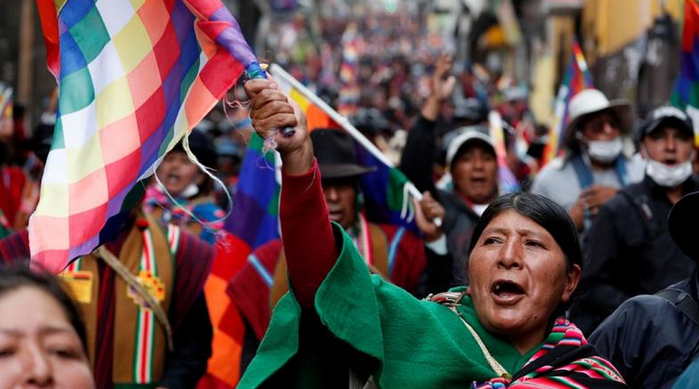
7. The revolt against austerity in Chile
What started in October 2019 as a student-led protest against metro fare increases quickly developed into a mass movement against 30 years of austerity in Chile. Within days, over a million people marched in Santiago to protest inequality and condemn police repression against protesters. Since Augusto Pinochet’s US-backed coup in 1973, Chile had been a laboratory for neoliberal reforms, which has led to the country’s massive wealth gap.
While their scale has decreased, protests continue to test Chile’s government. In late December, embattled President Sebastián Piñera announced that a referendum on a new constitution, including who might draft one, will take place in April 2020. The call for a new constitution has been a central demand of protesters, who want to secure their right to healthcare, education, and other public services.
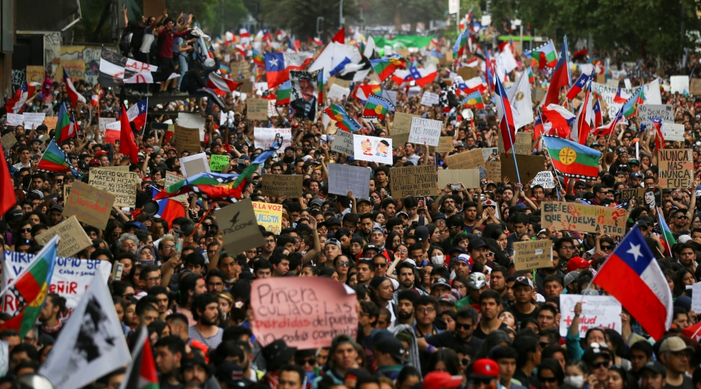
Middle East
8. Egypt, Lebanon, Iraq: A new Arab Spring?
The Arab world saw a wave of protests sweep the region in 2019, leading some observers to speculate whether a new Arab Spring could be on the horizon in the year ahead. In Egypt, where Abdel Fattah el-Sisi has cracked down on all forms of dissent since coming to power in a 2013 coup, a number of small but significant protests took place in September 2019, condemning the government austerity measures and widespread corruption.
In Lebanon, the scale of the protests has been much bigger, bringing the country to a standstill and forcing the government to resign en masse. What started as a protest over a proposed tax on WhatsApp has ballooned into a mass movement against corruption, inequality, sectarianism, and oppression: protesters now demand the removal of Lebanon’s ruling class and the creation of a new political system. Protests continued into December as the government struggled to meet the movement’s demands.
In Iraq, a large-scale movement emerged in Baghdad and much of the south in early October, when protesters demanded jobs and services and condemned government corruption. As the protests spread, their demands grew to include a an entirely new, non-sectarian political system. In the wake of recent US airstrikes on armed militia groups, some of which are part of the Popular Mobilization Forces, fresh protests have targeted the US Embassy in the Green Zone, provoking a crisis for both the Iraqi and US governments. Although Iraq’s months-old protest movement has yet to join demonstrators at the Embassy, who are calling for the full removal of US troops from Iraq, they support their demands and the potential remains for a united struggle to emerge.
The same conditions of austerity, poverty, and disenfranchisement—which provoked the Arab Spring in 2011—remain throughout the region and, in many cases, have become worse. As anger combines with confidence, and as 2019’s protests attract more support, the entire region could see the beginnings of another Arab Spring take root in 2020.

9. Anti-austerity protests in Iran
The people of Iran face two distinct struggles in 2020. The first is against its own government’s crackdown on the mass protests that emerged in November 2019 in response to a large hike in fuel prices, and which soon provided an outlet for pent-up anger at declining living standards.
The second is against the threat of a US-led attack on Iran. As protests in Iraq focus their rage on the American Embassy in Baghdad, Donald Trump has tried to blame Iran and escalated his threats of an attack against the country. Regardless of their stance on Iran’s government, the left outside Iran must be unconditional and unequivocal in its opposition to an attack on the country.
Africa
10. The next phase of revolution in Sudan
In December 2018, protests against the rising cost of bread spread across Sudan. In the months that followed, a full-scale revolution swept the country, toppling Sudan’s decades-long ruler, Omar al-Bashir, in April 2019, and leading to an agreement in August 2019 to initiate a transfer of power to a civilian government over 39 months.
However, as we learned from the Egyptian Revolution, the military will never really give up its power, and will patiently wait for the right moment to restore its rule and wipe out the gains of the revolution. In order to avoid the same fate, Sudan’s revolution will need to sustain its presence in the streets and resist calls to cede power to the Sovereignty Council of Sudan.
11. Protesters return to the streets in Algeria
Mass protests erupted again in Algeria in December 2019, calling for a boycott of the presidential election in which all five candidates had links to former President Abdelaziz Bouteflika, who was forced to step down in April 2019. Months before he resigned, in December 2018, scattered protests took place against Bouteflika’s attempt to run for a fifth term as President; by March 1, 2019, over three million joined protests across the country.
Like the Sudan’s revolution, Algeria’s continues to mobilize in order to prevent the ruling elites from seizing power for themselves and rolling back the gains of the last year. The coming year will be a critical period of transition, which will required sustained protests on the streets and in the workplaces to move the revolution forward.
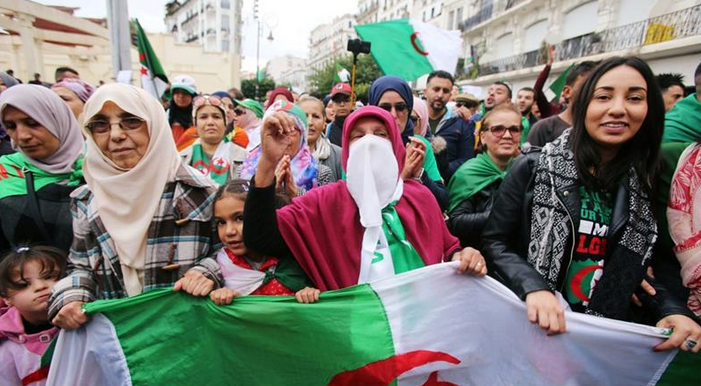
South Asia
12. Student-led protests against anti-Muslim citizenship laws in India
Mass protests swept the country in mid-December 2019, in response to Prime Minister Narenda Modi’s proposed Citizenship Amendment Act, which would fast-track Indian citizenship for non-Muslims who emigrate from Muslim-majority states in the region. Students have been at the forefront of the protests, including widespread condemnations of repression by the police, who recently stormed Jamia Millia Islamia university.
Demonstrations continued into New Year’s Eve, with “protest parties” planned in major cities all over India, and are expected to last well into 2020.
13. Kashmir’s struggle for national liberation
On August 5, 2019, India’s parliament revoked Kashmir’s special status, which gave the disputed region limited autonomy. Anticipating widespread protests, the Indian government has led an unprecedented crackdown on all dissent in Kashmir, arresting, detaining, and transferring hundreds of people, and shutting down the Internet and mobile phone calls.
While government repression may have prevented more visible protests, the situation remains in flux, especially as protests rage across India over Modi’s anti-Muslim citizenship law. Those protests will no doubt fuel anger in Muslim-majority Kashmir over the possibility that India will attempt to re-settle the region to promote Hindu nationalism.
East Asia
14. The democracy movement in Hong Kong
Millions of people have participated in pro-democracy protests in Hong Kong over the last six months of 2019, in opposition to a proposed bill that would have allowed suspects to be extradited to mainland China. Although the bill was withdrawn in September, the movement continues to mobilize for other demands, including universal suffrage.
In November, students faced off with police at Hong Kong’s Polytechnic University; just weeks later, pro-democracy groups won majorities in 17 of 18 councils in local elections. While protests slowed in November, hundreds demonstrated on New Year’s Eve, in advance of a mass march planned for January 1, 2020.
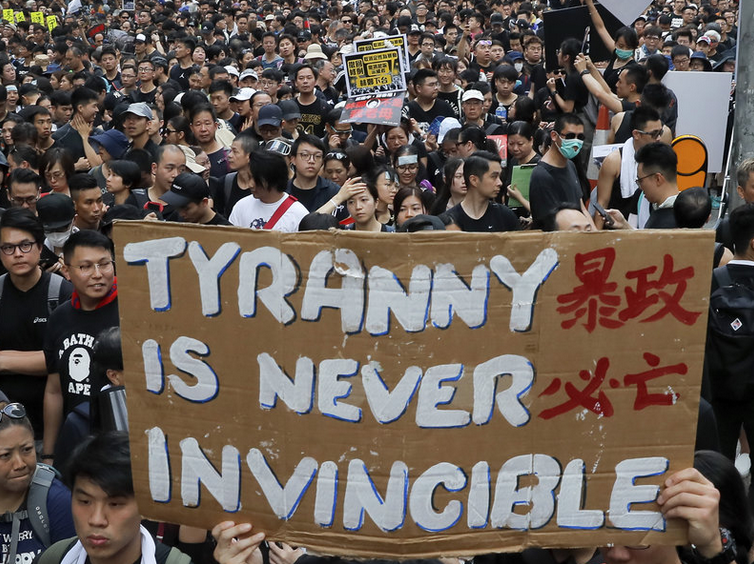
United States
15. The Bernie Sanders campaign
Although the corporate media has largely ignored, dismissed, or maligned his second run at the Democratic presidential nomination, it has recently admitted that Bernie Sanders could actually become the nominee. Since his first run in 2015, Sanders has given voice to dozens of grassroots struggles in the labour and social movements in the United States and, in the process, massively shifted mainstream politics to the left.
Sanders’ campaign is critical for the left because it represents the best chance to defeat Trump in the 2020 election: by building a mass movement of ordinary people in support of bold, progressive reforms that speak to real working-class concerns.
Britain
16. The Labour leadership contest
Labour’s historic defeat in the December 2019 general election has put wind in the sails of party centrists and liberal media pundits who have opposed Jeremy Corbyn’s anti-austerity agenda from the moment he entered the 2015 leadership race. It has also emboldened Democratic centrists in the United States who are terrified that Bernie Sanders might win the party’s nomination for President.
While not the most crucial working-class struggle in 2020, the Labour leadership race will generate critical debates for the left to engage, especially how a compromise on Brexit to accommodate party centrists eroded working-class faith in the party’s ability to carry out its bold platform.
Europe
17. Expanding strikes against pension reforms in France
After failing to quell months of escalating protests by the gilet jaunes movement in France, embattled President Emmanuel Macron faced a growing strike movement in December 2019, as trade unions launched a nation-wide mobilization against Macron’s proposed pensions reforms. Strikes continued throughout the holiday season, as workers at the Paris Opera House, including members of its orchestra who performed a free outdoor concert for demonstrators, joined the protests.
Another round of strikes are planned for January, with no signs of relief for Macron. If the movement defeats his reforms, it will give strength to all other anti-neoliberal struggles underway in France and across Europe.
Global
18. Climate justice
At the close of 2019, the world watched in horror as huge swathes of Australia were engulfed in wildfires, similar to the destruction of parts of the Amazon rainforest earlier in the year. In response to these and other climate-related events, the climate justice movement reached new heights in 2019, with the climate strikes in September bringing millions of people, mostly led by students, into mass political activity.
As frustration grows with the failure of governments to take effective steps to tackle climate change, especially in the wake of COP25 in Madrid, the climate justice movement will continue to dominate in 2020. But a key challenge facing the movement is its ability to connect demands for climate justice to the day-to-day struggles facing ordinary people in their workplaces: in order to make their struggle more immediate, accessible, and concrete, climate justice activists will need to recast their demands to align with working-class struggles for decent work, good jobs, public services, economic security, and equity—including migrant rights and Indigenous sovereignty.
19. Migrant rights
The movement for migrant rights has grown in size and influence all over the world, as millions of people fleeing war, persecution, inequality, and climate disasters seek refuge and a better life in countries far from their homes. During the 2019 federal election, migrant rights activists drew attention to the racism that informed most of the campaign and dominates the lives of immigrants, refugees, and migrant workers in Canada and around the world.
As the foreign policy agendas of rich, developed countries fuel more wars and climate disasters, more people will be forced to flee their homes and seek refuge elsewhere. Defending migrants’ rights and supporting their demands for justice should be a priority for activists in 2020, and a necessary complement to countering the racist scapegoating that attempts to deflect blame onto the most vulnerable groups for the economic decisions that continue to impoverish the global working class.
20. Anti-oppression
Anti-oppression struggles—against sexism, misogyny, transphobia and homophobia, Islamophobia and anti-Semitism, anti-Black racism, ableism, and other forms of oppression—were a central part of the protest movements that emerged in 2019, and represent their growing sophistication to tackle more than one issue at once. During the anti-austerity protests in Chile, young women led demonstrations against rape culture and misogyny; during the Sudanese Revolution, the women-led Kandaka in White campaigns gave leadership to the entire movement; during the anti-austerity protests in Lebanon, demonstrators condemned homophobia and sectarian-based bigotry in the country’s political culture; during the student-led protests against Ford’s cuts to education in Ontario, students grappled with questions about white supremacy and how structural racism affects organizing and activism.
This drive to equity will no doubt continue in 2020, especially among young people and newly radicalizing activists, but will also require as much support and reinforcement as possible from longer-standing activists in the face of arguments that try to deny the connection between oppression and the broader demands of our movements.
Video: Young women in Santiago perform a protest chant against rape culture and patriarchy in November 2019.
This list of twenty struggles is by no means exhaustive or necessarily representative, but it gives a sense of the dynamic movements that began or developed in 2019 and that will continue well into 2020 and beyond. While their successes so far are reason to feel optimistic about the year ahead, their outcomes are far from certain: socialists must do what they can to deepen solidarity with all of them, and to improve their chances that they’ll end in victory for workers and oppressed people everywhere.
Did you like this article? Help us produce more like it by donating $1, $2, or $5. Donate

